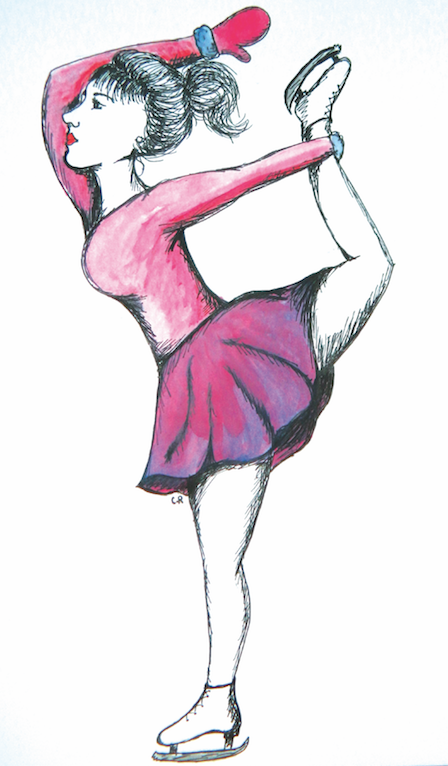During the winter of the sixth grade, I found myself at a crossroads unlike any other: it was the first year students at my school could both audition for the school play and try out for the volleyball team—two highly coveted after-school activities. Assuming I could do both, I tried out for each, only to find that the volleyball coach prohibited us from being in the play, claiming it was “too big of a time commitment,” and that the two “didn’t go together.” This rattled me. What was I going to do? I discussed it with all my classmates, but deep down I knew my path. While every other girl chose to bump and spike, I chose to dance and sing. This set the tone for the rest of my secondary school career. While my friends pursued athletics, I pursued acting, eventually leading me to attending an arts-focussed high school, and ostensibly leaving my passion for sports in the past.
The winter of grade six, however, also introduced me to what is now my favourite winter sport—ice dance. While it is similar to pairs figure skating, ice dance is derived from ballroom dancing. Quite literally, it is a couples’ dance routine on ice. This, of course, filled my 12-year-old theatrical heart with a newfound love. Ice dance is divided into two events: short dance and free dance. They are differentiated by their use of dance patterns and rhythms—another aspect I loved. In short dance, routines include a required dance pattern and a required rhythm (such as samba, rhumba, waltz, cha cha etc.), while free dance allows dancers to choose their own routine, encouraging creativity. Additionally, in all programs, the skating move of a ‘twizzle’ (a one-footed spin, done in unison and travelling across the ice) is mandatory, while throws or jumps are replaced by lifts. Dancers must also remain relatively close to one another throughout the program.
On top of all this, there is typically an emphasis placed on the theatrical narrative and the characters portrayed throughout the dance in the dancer’s moves and their facial expressions. This means many skaters chose to dance to musical theatre standards. It also means the costumes are designed to evoke a program’s theme, plot and characters. This sets the stage, or rather, the ice, for absolute drama—a show, if you will. In many ways, ice dance is musical theatre on skates.
I can vividly remember Tessa Virtue and Scott Moir winning their first Olympic gold medal at the Vancouver 2010 Olympics in my hometown. Here they were, two athletes with a passion for the theatrical. I had chosen theatre over athletics, but here was a whole olympic event full of people who had done both. I was speechless. No other sport filled me with the same sense of beauty, made me tear up, and wowed me both physically and artistically.
After 2010, I was hooked. I followed Virtue and Moir’s 2013-2014 season leading up to the 2014 Sochi Olympics. I watched their television show Tessa and Scott, researched ice dance, and familiarized myself with their (and their competitors’) programs. Their silver medals in 2014 broke my heart. The first time I ever skipped school was in grade ten, after watching them miss out on gold. My best friend and I headed to Starbucks after lunch period, bought hot chocolates and scones, and (with tears streaming down my face) we re-watched their programs. Thinking they were retiring, I too, retired my fandom for the next four years.
Upon learning Virtue and Moir would return to PyeongChang, I immediately began doing catch up research. Yes, they are fan and judge favourites, but something about their presence on ice keeps their fans on our toes. In their PyeongChang 2018 Olympic performance, they set a world record (on International Skating Union grading scales), scoring 83.67 with their short dance. Their free dance, however, did not score as high as the French dancer’s Gabriella Papidakis and Guillaume Cizeron’s program to Moonlight Sonata (a score of 123.35, also a world record). Despite earning a second-best score in the free dance, Virtue and Moir won their second gold medals because of their combined score. Virtue and Moir’s free dance was, in my opinion, the most innovative and captivating skate of the night. Their free dance routine this 2017-2018 season has it all: the music is from Moulin Rouge, an acclaimed modern musical, the dancing is feverish, and it is extremely sexually charged—one lift needed to be toned down before the Olympics, as it was too ‘suggestive.’ Their record-breaking combined score of 206.07 (short and free dance scores together) has made them not only the most decorated ice dance team of all time, but a source of inspiration for athletes and artists everywhere.
Ice dance is one of those rare places where art and sport intertwine. Covered in sequins, dolled up in stage makeup, ice dancers bring together athletics and theatre in a way that is gold medal—and Tony Award—winning. Never in my life did I expect that my knowledge of musical theatre would be an asset in watching a sporting event, and yet, somehow, dreams have come true. If stage presence gets you to the Olympics, never again let your grade six volleyball coach tell you sports and theatre don’t ‘go together’—ice dance proves that wrong.

